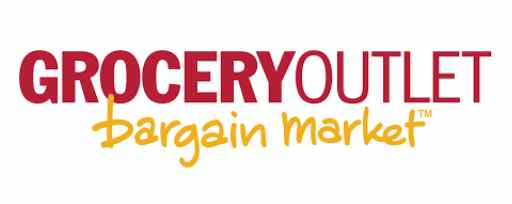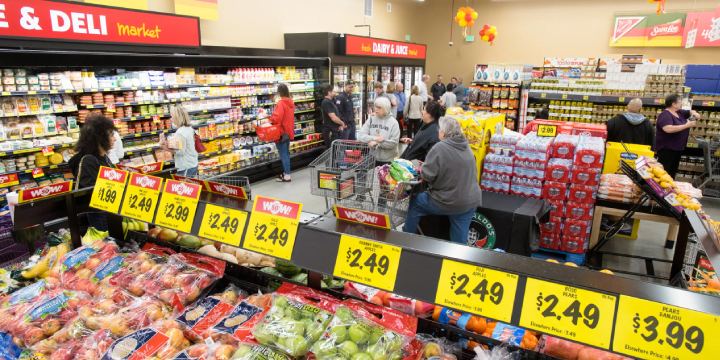From Private Label to Tech Upgrades:
How Grocery Outlet is Shaping Discount Grocery

Grocery Outlet, a rapidly growing extreme-value retailer, has been transforming the grocery landscape through its unique business model and strategic expansion. Based in Emeryville, California, the company operates over 520 stores across 16 states, offering a wide variety of quality, name-brand consumables and fresh products at steep discounts. With a focus on providing value and enhancing the customer experience, Grocery Outlet has solidified its place as a leader in the discount grocery space, all while embracing technology and growing its store footprint at an impressive rate.
At the core of Grocery Outlet’s success is its opportunistic sourcing model. This allows the company to purchase products—often name-brand consumables—at significant discounts from suppliers facing overproduction, packaging changes, or near sell-by dates. As a result, the company offers shoppers prices that are typically 40% lower than traditional grocers and about 20% lower than leading discount retailers. This “treasure hunt” shopping experience not only attracts bargain hunters but also keeps customers returning for the ever-changing product selection.
Grocery Outlet’s independent operator model adds another layer to its differentiation. Each store is independently operated by local families who manage the business with deep ties to the community. This decentralized approach provides flexibility for operators to cater to local tastes while maintaining the company’s core value proposition of affordability and quality.
CEO RJ Sheedy underscored the importance of this model during a recent earnings call, saying, “Our unique model of independently operated stores combined with our ability to offer steep discounts on quality products creates a compelling shopping experience that our customers trust.”
While the company’s roots are in the West Coast, Grocery Outlet has been expanding aggressively across the country. With a footprint that now spans from California to Pennsylvania and Tennessee, Grocery Outlet plans to open over 55 new stores by the end of 2024. This growth is fueled by the company’s acquisition of United Grocery Outlet (UGO), adding 40 stores across six southeastern states, including Alabama, Kentucky, and Georgia.
This strategic acquisition is pivotal for the company’s long-term goals, as it extends Grocery Outlet’s reach into the Southeastern United States, a region previously untapped by the retailer. “UGO provides a great entry point into the Southeast as part of our larger store fleet expansion goals,” Sheedy explained. By bringing the company’s extreme-value offerings to a new demographic, Grocery Outlet is positioning itself for continued growth, with plans to eventually operate over 4,000 stores nationwide.
Our compelling savings and ever-changing assortment of high-quality ‘wow’ items continue to drive healthy traffic increases and market share gains.

Strategic Growth and National Expansion
A Unique Business Model Driving Success
Grocery Outlet’s commitment to enhancing the customer experience through technology is central to its success. The company recently upgraded its inventory and financial reporting platforms, although the transition led to some operational disruptions. These upgrades, which include enhanced data analytics, are designed to improve visibility into operations, streamline inventory management, and forecast margins more effectively.
Despite the initial challenges, Sheedy remains optimistic: “While the transition caused some disruptions, we are now seeing improved data visibility, system speed, and operational efficiencies. This will help us drive better margins and ultimately improve the customer experience.”
One of the company’s more significant tech innovations is its mobile app, which was rolled out to all stores earlier this year. The app provides personalized deals, increasing customer engagement and loyalty. “The app has seen a strong response, with over 400,000 downloads so far,” Sheedy noted. “Our app transactions show higher basket sizes than non-app transactions, and we believe this will help drive trip frequency and wallet share.”
The app is just one piece of Grocery Outlet’s broader digital transformation. The company is also investing in new handheld technology for operators to improve inventory management, product receiving, and overall efficiency.
Grocery Outlet is also poised to increase its profitability with the launch of its private label program, starting with the Simply Go brand. This initiative is expected to add over 100 private label SKUs by the end of 2024. The company’s private label offerings include staples such as baking products, pasta, and dairy, as well as more unique items in its organic and specialty line, NOSH (Natural, Organic, Specialty, and Healthy).
These private label products will complement the store’s “treasure hunt” atmosphere while offering customers high-quality, affordable alternatives to name-brand goods. Sheedy emphasized the strategic importance of private label expansion: “These items will help us capture larger baskets and create a stickier customer relationship. By providing consistent, everyday value, we’re delivering better margins and a better experience for our customers.”
The Role of Technology in Enhancing Customer Experience
Private Label Expansion: Capturing Larger Baskets

In addition to driving profitability through private labels and technology, Grocery Outlet is committed to sustainability. Currently, over 98% of its stores use timed lighting and heating systems to reduce energy consumption. The company also utilizes cloud-based refrigeration analytics in 17% of its stores to lower energy use and monitor refrigerant leaks. Plans are in place to expand this technology to more stores, with a goal of reducing the company’s overall environmental footprint.
As part of its opportunistic sourcing model, Grocery Outlet’s approach to buying surplus or excess products not only benefits customers but also helps divert food waste that might otherwise end up in landfills. The company is exploring ways to quantify the environmental benefits of its sourcing model in the future.
Despite its growth, Grocery Outlet has faced some headwinds. The transition to its upgraded tech platforms in late 2023 caused disruptions in operations, leading to reduced gross margins and muted same-store sales growth. However, these setbacks are temporary, and the company is focused on resolving system integration issues while improving its payables process and forecasting capabilities.
Sheedy acknowledged the challenges but expressed confidence in the company’s ability to bounce back. “We are all frustrated by the size and duration of this disruption, but it is temporary, and we are on the right path forward. We are making good progress with our systems transition, and we remain focused on improving visibility and operational efficiency.”
As Grocery Outlet continues to expand its store base, embrace new technology, and launch its private label program, the company is well-positioned for future growth. With a target of eventually operating over 4,000 stores across the United States, the company’s ambitious growth plans are underpinned by its unique business model, customer-centric innovations, and strategic market expansion.
“We’re bullish on our growth opportunities,” Sheedy said. “Our business fundamentals are strong, and we are excited about the future as we continue to enhance the value we bring to customers, communities, and operators.”
In an industry where value, convenience, and customer engagement are paramount, Grocery Outlet has set itself apart as a leader in the discount grocery space. As the company looks ahead, it is clear that its blend of opportunistic buying, technological innovation, and community-focused operations will continue to drive success in the competitive grocery landscape.



